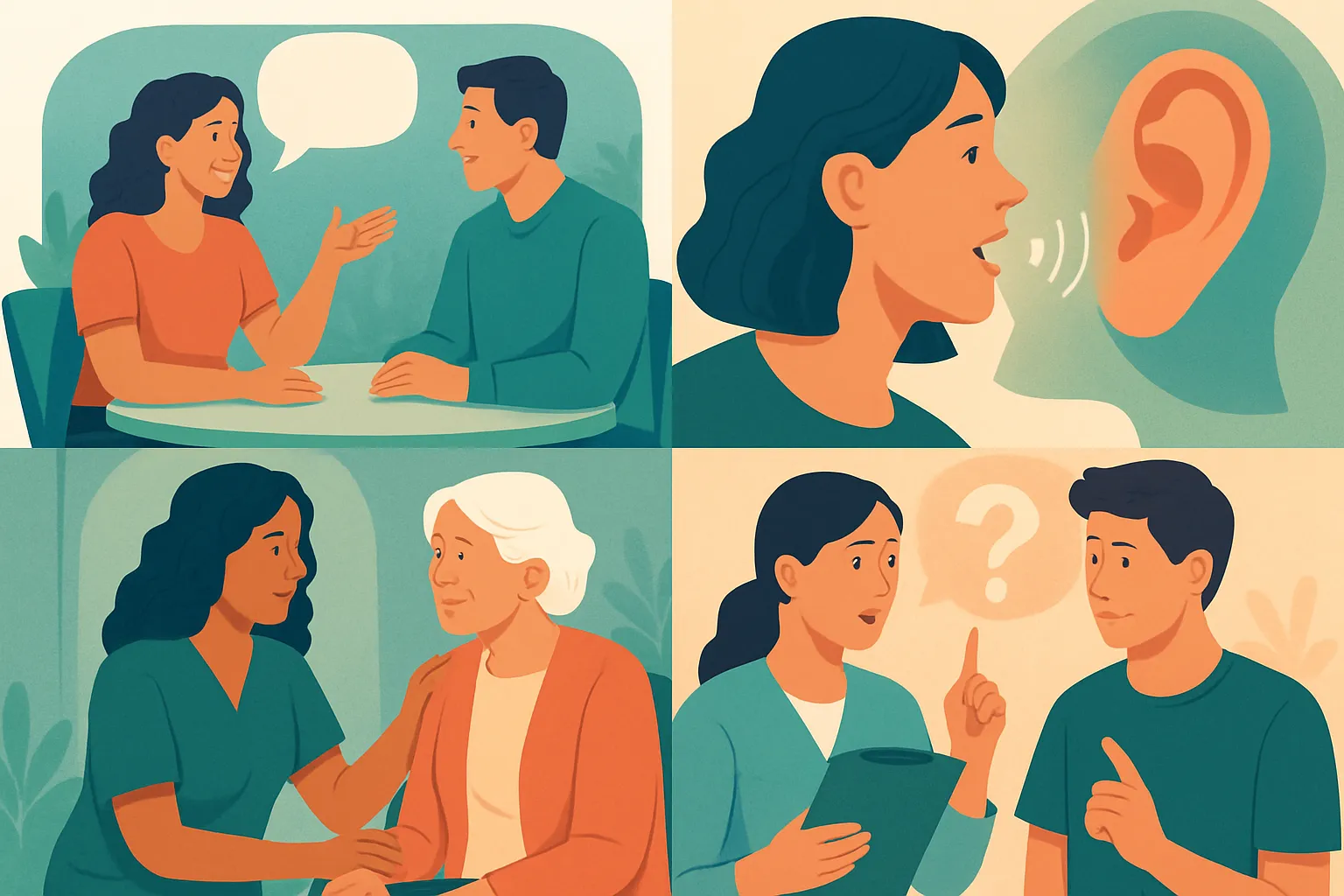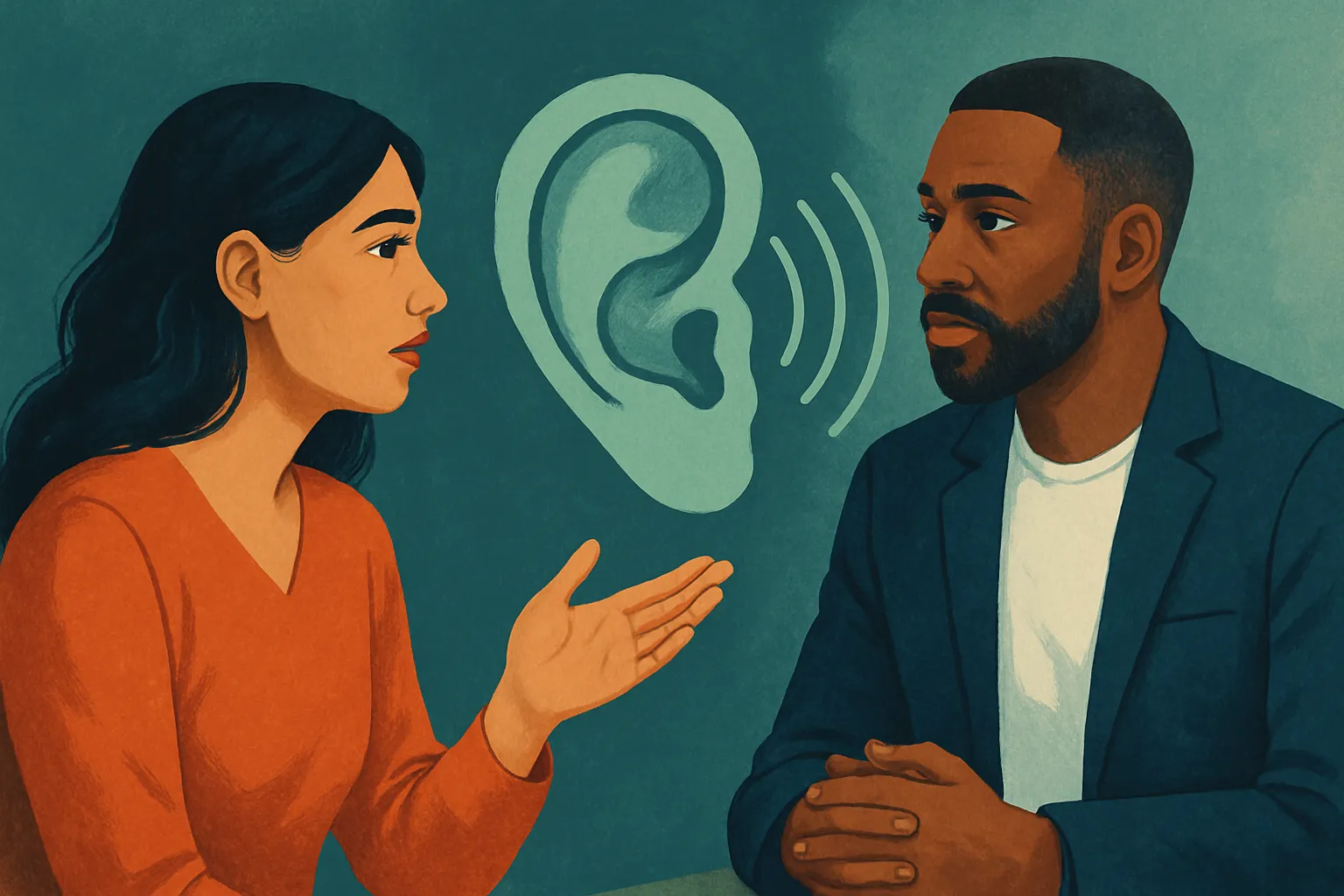Curriculum
- 15 Sections
- 15 Lessons
- 2 Weeks
- Understanding Your Role2
- Duty of Care2
- Equality and diversity2
- Person-centred care and empowerment2
- Communication2
- Privacy and dignity2
- Fluids and nutrition2
- Awareness of mental health, dementia and learning disabilities2
- Safeguarding adults2
- Safeguarding children2
- Basic life support2
- Health and safety2
- Handling information2
- Infection prevention and control2
- Understanding learning disabilities and autism2
Curriculum
Communication
Learning Objective:
Understand and apply fundamental communication techniques for effective, person-centred care.
Basic communication techniques

Basic communication techniques are essential for health and care workers to deliver effective and compassionate care. Clarity of message, appropriate tone, and pacing are key principles. Always speak clearly using simple language that the individual can understand, especially when giving instructions. Maintaining a warm tone can help establish trust and rapport, ensuring individuals feel respected and valued. It’s equally important to confirm understanding, to ensure the recipient accurately comprehends the information you provide. For instance, when explaining care procedures, ask the individual to repeat key steps to affirm their understanding.
- Clarity
- Tone
- Pace
- Open-ended Questions
Clarity means conveying your message in a way that is easily understood, minimizing misunderstandings.
Tone refers to the emotion or attitude conveyed in your voice; a warm tone can enhance compassion.
Pace is the speed at which you speak; moderate pace helps comprehension.
These are questions that encourage detailed responses, fostering more informative communication.
Barriers to effective communication

Effective communication can be hindered by various barriers. Recognizing these barriers is crucial to avoid miscommunication and support person-centred care. Common barriers include language differences, hearing difficulties, environmental noise, and personal biases. Addressing these barriers ensures you can adapt your communication methods to each individual’s needs, creating a more inclusive and supportive care environment.
Environmental Barriers
Noisy settings can make it difficult to hear and understand conversations. Reducing background noise or moving to a quieter location can help.
Emotional Barriers
Stress or anxiety can impact an individual’s ability to process information. Maintaining a calm and supportive demeanor can help alleviate these emotional barriers.
Cultural/Language Barriers
Differences in language or non-verbal cues can lead to misunderstandings. Using a translator or visual aids can improve communication clarity.
Use clear and simple language
Avoid jargon and complex terms unless they’re clearly explained. This makes information accessible for everyone.
Confirm understanding
Ask questions to ensure the recipient has understood your message. Use phrases like ‘Can you tell me what you understood?’.
Adapt your pace or tone
Adjust the speed and emotional tone of your speech based on the situation and the individual’s needs.
Seek clarification if unsure
If a message is unclear, don’t hesitate to ask questions to clarify and ensure everyone is on the same page.
Recording and reporting

Accurate recording and reporting are critical components of care workers’ duty of care. Ensuring that all documentation is precise, maintaining confidentiality, and adhering to organizational procedures when documenting incidents or complaints are fundamental to safeguarding individuals in your care. Proper record-keeping enables key stakeholders to access necessary information to provide informed and consistent care.
- Step 1: Identify the issue clearly
- Step 2: Follow organizational policies
- Step 3: Report through proper channels
Clearly determine what needs to be recorded, such as incidents, observations, or complaints.
Use the required documentation methods set by your organization, such as care plans or risk assessments.
Inform your manager or use the official reporting process to communicate concerns.
Active listening skills

Active listening is a critical skill in health and social care, helping you understand the needs and expressions of those you support. Effective listening involves maintaining eye contact, avoiding interruptions, and asking clarifying questions. This practice creates a more comprehensive understanding of the individual’s needs, facilitating better communication and care.
Empathy in communication

Empathy is crucial in care work, involving willing understanding and appropriate responses to others’ emotions. Empathy supports dignity and trust-building, distinguishing it from detached communication. An example of this includes responding with understanding when someone shares distress rather than minimizing their feelings.
- “I understand you feel overwhelmed.”
- “You’ll be fine.”
- “How can I help you feel more at ease?”
This reflects empathy by acknowledging the person’s emotional state.
This statement lacks empathy; it dismisses the person’s feelings.
This shows empathy by offering support and recognizing the individual’s needs.
Non-verbal communication cues

Non-verbal communication such as body language, facial expressions, and gestures can be as powerful as words. These cues can convey respect, understanding, and empathy, significantly affecting care dynamics. Being aware of such cues helps caregivers maintain professional interactions and recognize the unspoken needs of those in their care.
- Facial Expressions
- Gestures and Posture
A smile can convey warmth and openness, while a frown may indicate displeasure or confusion.
Open postures, like facing the person directly, can signal attentiveness, while crossed arms may appear defensive.
Collaborative communication in team-based care

In team-based care, collaborative communication is essential for ensuring continuity and quality in patient care. Effective communication within a team allows for the sharing of best practices and the resolution of conflicts in a professional manner. It ensures everyone is updated and aligned with patient care plans and responsibilities.
- Establish regular team meetings
- Report important observations
- Confirm instructions received
- Use active listening among peers
Conduct meetings consistently to discuss ongoing and upcoming tasks, ensuring everyone is informed.
Share crucial observations about patients or care procedures promptly with the team.
Always verify any instructions you receive within your team to avoid misunderstandings and errors.
Ensure you understand colleagues by fully listening and clarifying any doubts.
Cultural competence in communication

Cultural competence in communication involves acknowledging, respecting, and adapting to diverse cultural backgrounds. This competence fosters dignity and equality while reducing misunderstandings and conflicts. Being culturally competent means recognizing differences and incorporating these understandings into communication and care practices.
Using technology to enhance communication skills

Modern technology is an invaluable tool in enhancing communication skills within healthcare sectors. Technologies such as electronic health records (EHRs), secure messaging platforms, and teleconferencing improve communication speed and accuracy, facilitating better caregiving outcomes. These technologies expedite information sharing and support teamwork and collaboration.
- Logging into digital systems securely
- Navigating user interfaces
- Inputting required information accurately
- Ensuring data confidentiality
Use secure practices, like strong passwords and two-factor authentication, when accessing systems.
Familiarize yourself with the layout and functions of the digital tools you use.
Ensure all entries in digital systems are precise to maintain accurate records.
Follow privacy guidelines to protect patient information when using digital tools.
Patient-centered communication strategies

Patient-centered communication focuses on prioritizing the needs, preferences, and values of individuals receiving care. This approach not only honors their rights and dignity but also empowers them to participate actively in their care. Through patient-centered communication, care workers can build a partnership that enhances the overall quality of care.
- Use clear and jargon-free language
- Encourage questions
- Show empathy through body language
- Record patient preferences
- Collaborate on care plans
Avoid technical terms; use language the patient can easily understand.
Invite patients to ask questions, clarifying doubts and ensuring understanding.
Use gestures like nodding and maintaining eye contact to demonstrate attentiveness and care.
Keep detailed notes of patients’ likes, dislikes, and preferences to tailor care plans.
Include patients in the decision-making, ensuring their inputs shape their care.